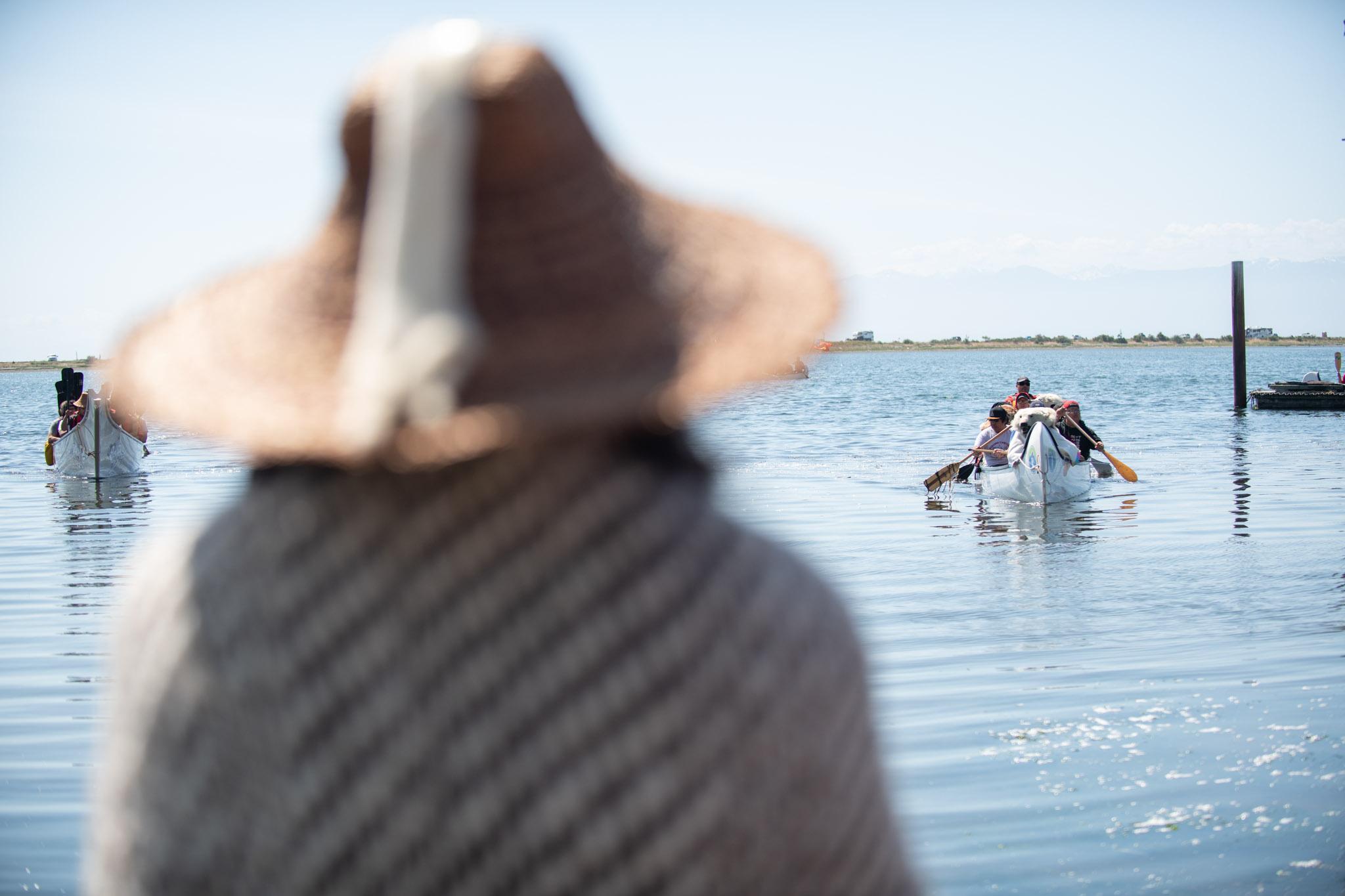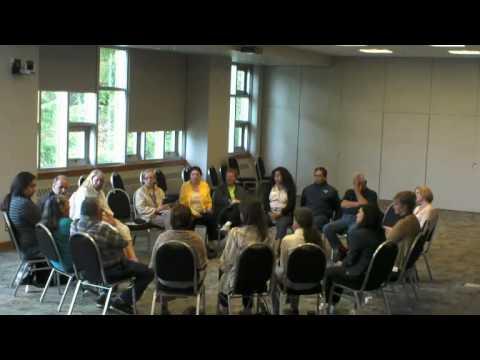The Tse Tsa Watle Speaker Series: Coming Together to Help One Another
Share online

On September 30, 2023, we mark the third annual National Day of Truth and Reconciliation in this land now known as Canada.
In the days leading up to September 30th, the School of Leadership Studies (SLS) is posting a series of blogs with resources to support ongoing learning in pursuit of truth, justice, decolonizaton, and reconciliACTION.
In today’s post, Dr. Virginia McKendry shares videos from the “Tse Tsa Watle” Speaker Series.
Tse Tsa Watle
The “Tse Tsa Watle” Speaker Series (TTWSS) was a participatory action research project that ran between 2011 and 2013 at Royal Roads University. During the series, an intercultural learning community formed itself around an emergent team of Coast Salish Elders, Old Ones, Knowledge Keepers, and cultural specialists, including: Greg Sam (Tsartlip), William A. White B.A. (Qwut’sun, Snuneymuxw), Linda Bristol (T’sou-ke), Burt and Lavina Charles (Scia’new), Dan Sam (Tsartlip), the late Dr. Pakki Chipps PhD (Scia’new and Greenland Inuit), Dave Bodaly (Snuneymuxw), Doreen Pelkey (Tsawout), Eric Pelkey (Tsawout), and Mary Jack (Tseycum) and her son Paul Wagner. The series was co-hosted by Greg Sam and Dr. Virginia McKendry PhD (School of Communication and Culture, RRU) and William A. White, with generous support from the university, especially the gift of the time of RRU media technicians Dave Adams and Dan Anthon.
“Tse Tsa Watle” is the phonetic spelling (for ease of pronunciation for non-speakers) of the Hul’qumi’num (a Salishan dialect) phrase t’si t’suwatul, which roughly translates to “everyone coming together to help one another.” The name of the series was chosen to signal this learning community’s desire for the university and Coast Salish neighbours to work in partnership, learn from one another, and share our strengths. It did not take long for the invited Elders, Old Ones, Knowledge Keepers, and cultural specialists to organically form a larger collaborative leadership team, which led to several on-site and off-site luncheons and visits to foster more ideas of how to mutually engage the communities for maximum benefit. At the end of the series, qualitative interviews were conducted with speakers and the various faculty, staff, students (including a class from Netherlands and a group of students from Yekuche First Nation), and visitors from the wider community who attended one or more sessions. The results of the data show that the series succeeded in its goals of using traditional storytelling to create awareness of the forgotten, hidden, and suppressed stories of Indigenous histories and biographies and an appetite for re-learning what it means to be in good relationship with the First Peoples of these unceded lands.
To the extent that this action research succeeded, it did so because of the series’ heavy emphasis on storytelling, the core way that Indigenous people teach, learn, and work together. Stories resonate with the whole self, body, mind, and spirit, and they carry the truths that more abstract knowledge can often fail to convey. In this way, TTWSS storytelling offered the RRU learning community both a tool for Indigenous resurgence and the strong settler effects we were hoping to achieve.
The series ran only for two years, but the seeds had been planted for better working relationships between the university and First Nation/Métis/Inuit communities. Certainly, the TTWSS experience prepared RRU to be ready and able to mount a much more intentional response to the formal calls for Truth and Reconciliation that came in 2015. The Truth and Reconciliation Commission (2015) was clear that “Reconciliation calls for personal action. People need to get to know each other. They need to learn how to speak to, and about, each other respectfully” (p. x). Four years before that report was published, TTWSS speaker and the late T’Sou-ke Elder Linda Bristol said as much during her TTWSS session, when she stated, “Before we can work together, we need to get to know each other.” We hope that you will learn and benefit as much as our TTWSS community did when these sessions were first recorded. We also hope you will appreciate that although many good things have happened since then, there are still more stories to be told and more work to do.

The Photo above shows an example of a Tse Tsa Watle learning circle. Participants consented to the photography, and faces are intentionally blurred to promote anonymity.
Resources
Tse Tsa Watle Speaker Series – an overview, with William A. White and Virginia McKendry
A poster session from a conference at RRU, where Bill White and Virginia McKendry describe the TTWSS and the underlying reasons for creating the learning community
TTWSS Session with William A. White (Snuneymuxw/ Qwut’sun)
Bill White brings a list of questions about Indigenous peoples from school children to help break the ice, telling stories about his own Elders and their teachings.
TTWSS Session with Burt and Lavina Charles (Scia’new)
Burt and Lavina Charles share many stories, including what it was like to be raised in the traditional way and in their own languages, how Indian day school damaged his identity and how, later in life, he turned to his Elders and his cultural teachings to find his strength. He explains how, though he had only a Grade 4 education, how he used his time as band councillor and elected chief to make things better for his people, and the importance of education for the younger generations.
TTWSS Session with Doreen Pelkey (Tsawout)
Doreen Pelkey, a fluent language speaker and unique for being a female drummer and singer due to her extensive cultural knowledge, tells stories about the importance of family, and stories about racism and discrimination she endured while growing up.
TTWSS Session with Pakki Chipps (Scia’new/ Greenland Inuit)
The now late Dr. Pakki Chipps shares wonderfully rich stories about traditional plant knowledge and stewardship methods, and how this knowledge belongs to various families and why it is important to respect this form of intellectual property.
TTWSS Session with Dave Bodaly (Snuneymuxw)
Dave Bodaly is from Snuneymuxw First Nation and has worked as a photographer/ genealogist for First Nations on Vancouver Island. In this session, he shares his knowledge and images of the histories, genealogies, hereditary names, territory and place names of Coast Salish people. A class of students from Netherlands were there that day and they were riveted, sharing their own stories about suppressed indigeneities in their part of the world.
TTWSS Session with Mary Jack and Paul Wagner (Tseycum)
This final session of TTWSS features Elder Mary Jack and her son Paul Wagner. Paul begins the session by explaining how Indigenous storytelling works and how it differs from dominant Euro-American ways of storytelling and then demonstrates for the people gathered. Mary then regales everyone with stories about the animals she knew and befriended as a little girl.
---- No video available -----
TTWSS Session with Linda Bristol (T’Sou-ke)
The now late Linda Bristol speaks about the history of “how we got here” and how quickly smallpox epidemics and residential schools nearly annihilated local cultures and languages. She talks about the specificity of Indigenous cultures and why you won’t find tipis on Vancouver Island. She explains the great burden living under the Indian Act and how Bill C-31 discriminated against Indigenous women who married non-Indigenous men, dispossessing them (and their children) of their cultural heritage and band membership. She emphasizes how important it is to get to know one another and ot find creative ways (e.g., film, novels, TV) to bring more accurate stories of Indigenous life and thinking to non-Indigenous people.
TTWSS Session with Dan Sam (Tsartlip)
Dan Sam shares stories of his working life, and how he turned his life around after becoming disconnected from his culture. He credits the Indian Shaker Church that was so key to his mother’s resilience for helping him finding his way back to his true identity and a good way of living, demonstrating how they “brush off” illness, sadness, and other forms of distress.